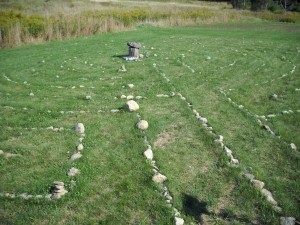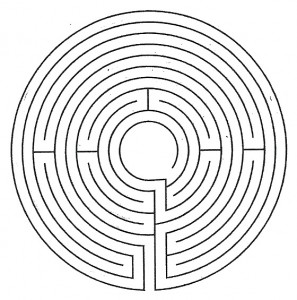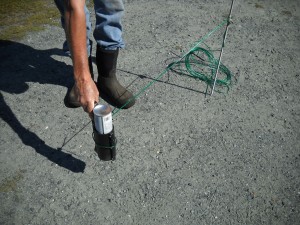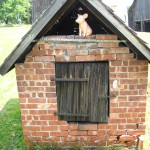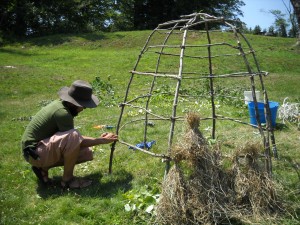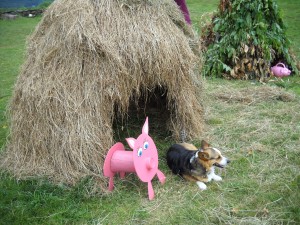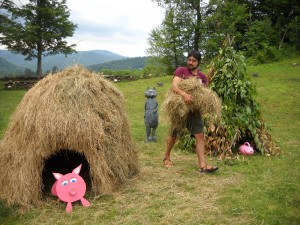Labyrinths
Despite my jokes to the contrary, I know that you gardeners won’t really turn to a life of crime now that gardening is over for the summer. But you might go into a decline, wasting time watching afternoon television or reading trashy novels. Don’t. Please don’t. There are always possibilities for projects outside, even after flowers and vegetables are through for the season. One such project to consider is building a labyrinth.
I recently visited a labyrinth at Harmony Farm, a non-profit nature-based education center, open to the public at 28 Bowers Rd, Hartland, VT. (www.harmonyfarmvt.com). They have built a 55- foot diameter labyrinth in memory of Derek Cooper, a young worker at the farm who is now deceased. It is a simple, though time-consuming project that, once completed can be very spiritual in nature.
Labyrinths are sometimes confused with mazes. Both involve walking a path in an area usually defined by a circle. But a maze is a puzzle with many choices about which way to go. A labyrinth has no choices. The pathway winds around, turns corners, and seems to go to the center of the labyrinth – only to turn and lead back to the outside. Eventually you reach the center after walking every step of 7 or more concentric circles.
History is unclear about the origin of labyrinths. Labyrinths appeared in Crete and Egypt over 2,000 years ago. They were introduced inside Catholic cathedrals in Italy in the 12th century and in France in the 13th. Worshippers walked them as a way of calming the mind and becoming at one with God. Some crawled on their knees while praying. Some walked labyrinths instead of going on a pilgrimage. Famous labyrinths are at the Cathedrals in Chartres, Reims and Amiens in northern France, but now they can be seen outdoors all over the world.
Knox Johnson, one of a family of farmers and gardeners living and working at Harmony Farm, introduced me to their labyrinth and explained how it was created. The first step in creating a labyrinth was to find a relatively open, flat space for it. Barbara Johnson recommends getting someone to dowse the site to find just the right spot, using either crystal dowsing, or rods.
Once the spot was identified, Knox tilled the soil late in the summer of 2011. He allowed the weeds and wild grasses to come back for a few weeks and then tilled it again, getting rid of most of them. He added lime to improve the soil pH. He raked the area, smoothing out the surface and finally seeded it with a seed mix called “Eco Blend with Clover” from North Country Organics (www.norganics.com).
Clover is good in a seed mix because clover plants fix nitrogen from the air, turning it into useful nitrogen and enriching the soil. Unfortunately, many seed companies no longer include clover seed in their mixes because “weed-n-feed” treatments have herbicides that kill clover. So clover has been declared a weed.
This summer the real work began. Once the grass was well established, Knox and a friend laid out the pattern. He used a device that holds a can of spray paint to mark out the lines. He used a long light-weight cable to define the circles. The spray paint in its holder was attached to one end of the cable, while the other end was looped over a stake in the center of the labyrinth.
Knox sprayed white paint while keeping the cable taut. The center of the labyrinth is a 4-foot space which eventually was surrounded by seven concentric circles, each 31 inches apart from the next. He had a design copied from the cathedral in Bayeux, France, and used stakes to mark turns in the walkway. He told me it really on took an hour or two to mark the lines.
Because of all twists and turns, that path to the center of the labyrinth is about 1,000 feet from the entrance. That amounts to a lot of stones needed to line the path. They used smallish stones, so 4 or 5 were used in every foot. But if you create your labyrinth you can use whatever size you want.
Knox directed me to the Universalist Church in Hartland, VT, just half a mile from the labyrinth at harmony farm. Bryce Lloyd, a Boy Scout, built a lovely labyrinth near the church as his Eagle Scout project. Bryce used larger stones, and installed gravel instead of allowing grass to grow. I assume that landscape fabric was put down beneath the gravel to keep weeds out – though some weeds will persist no matter what, I fear.
Walking a full-sized labyrinth like the one at Harmony Farm takes 5 minutes or so. I find that walking one is an easy way to clear the mind and to forget for a few minutes the deadlines and worries of life. One moves forward, one turns back, one concentrates on the journey. I find walking a labyrinth very relaxing. I don’t think I will build one myself, but they are nice to visit and are more common than you might think.
Henry’s new book is out: Wobar and the Quest for the Magic Calumet from Bunker Hill Publishing. It is a chapter book for kids, a fantasy-adventure about a boy born with a mustache and a magical ability to speak to animals and understand them. Learn more at www.Gardening-Guy.com.
Garden Wimsy
If you ask my grandchildren, they would probably tell you that “Silly” is my middle name. George may remember the time Grampy showed up at his house wearing one red high-top sneaker, one purple. Or Casey might tell you about the Superman cape on the scarecrow that is currently in my garden. So they were not surprised to see that, with some help, I have put together a full-sized representation of the story of the Three Little Pigs, complete with pigs and a wolf. I love garden whimsy, and encourage you to think about creating outdoor art for your own garden. It doesn’t take great skills to create something fun.
This particular whimsy is on public display in Woodstock, Vermont at the Vermont Land Trust offices on Hunt Farm Rd, off Rose Hill Rd. It is part of an event called Bookstock – a one day event that has already passed by. But the Poet’s Trail, which is under the auspices of Bookstock, will continue into the fall, overlapping with Sculpture Fest which is held nearby. It features poems by Mary Oliver selected by Woodstock High School students that are posted along the trail, and lots of fabulous sculpture along the trail, in the fields, and around the old farmhouse. There’s a little whimsy, too.
At the farm there is a tiny old brick building (just 5 feet square and 6 feet tall) built long ago to store ashes, presumably for making soap. Charlet Davenport, the organizer of the Poet’s Trail event, told me she thought the brick house would be great as part of the Three Pigs story, but needed someone to build a straw house and a stick house. I agreed to do so.
I built the houses with the help of my summer intern, Gordon Moore. They are circular and 6 feet in diameter at the base. The straw house has a rounded top and the stick house is built like a teepee.
The houses are made with freshly cut saplings, each an inch or two in diameter and 8 feet long. We stripped off side branches and leaves, and then dug 6-inch deep holes for each sapling. After placing the sticks in the holes we tied them together at the top using copper wire that we stripped out of scrap #14 building wire that I had left over from the days when I was an electrician.
For the straw house we bent over opposing sticks, overlapping them and tying them together for a foot or more, creating a domed top. For the stick house we tied 3 together as if we were building a teepee, then added 3 more in between the first three. Once that was done, we filled the holes in the ground with soil and some gravel to firm it up and keep each stick in place – just in case a wolf wanted to huff and puff at our pig homes.
Then the real work began. We took small diameter sticks (half to quarter-inch) and tied them around the outside of the houses with wire. We did 5 or 6 concentric circles descending around the outside of our little pig houses. That provided stability and places for us to tie on bundles of straw (actually, we used hay, not straw, nearly 2 bales of it) or clumps of twigs with the leaves left on. We needed to create something that enclosed our structure but was not so solid as to deter the mythological wolf.
For the straw house we tied more than 150 clumps of hay. We used ordinary 3-stranded garden twine, which was strong enough to tie our bundles together without breaking when we cinched them together. For the stick house we made similar bundles, using the side branches, leaves and all, that we had cut off our saplings that we used for the framework. The stick house was easier – we could make 2-foot long bundles that quickly covered the exterior of the stick house. I found that using a knot I learned in Boy Scouts, a clove hitch, to tie the bundles together worked best.
I had a nice pig watering can (made of plastic) and a ceramic piggy bank, but needed a good-sized pig for the straw house. My partner, Cindy Heath, sketched out the face and front legs of a pig onto a piece of quarter-inch birch plywood, and I cut it out with a jig saw. Then we made the back end of the pig, and I screwed each end onto a short pine log about 6 inches in diameter. We painted it pink, Cindy painted on eyes, and I attached a tuna can for a snout. It looked great – and undoubtedly tasty to passing wolves.
I called the former mayor of Hanover, Marilyn “Willy” Black to ask if I might borrow a wolf. She is a chainsaw artist, and agreed to lend me the original wolf she made many years ago. She re-painted it, and I installed it in a menacing pose behind the houses. Beware, pigs!
All together Gordon and I spent about 15 hours each making the 2 houses, and Cindy and I spent another hour each on the pig.
One could look at this as a colossal waste of time, or perhaps as a worthy endeavor – given that this exhibit will create plenty of smiles and a few giggles from my grandkids. Think about creating something fun (or silly) for your own garden – especially if you have kids or grandchildren.
Henry’ Homeyer lives and works in Cornish Flat, NH. You may write him at P.O. Box 364, Cornish Flat, NH 03746 or henry.homeyer@comcast.net.



